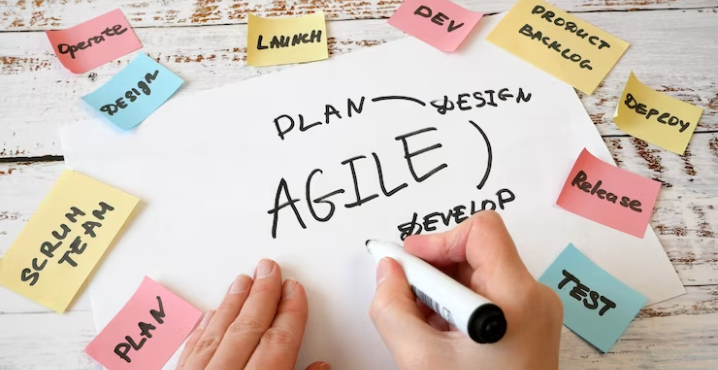
Related Articles

IT Outsourcing
RSK BSL Tech Team
May 4, 2025
|
|

Mobile Application Development
RSK BSL Tech Team
April 30, 2025
|
|

Software Development
RSK BSL Tech Team
April 27, 2025
|
|

Hire resources
RSK BSL Tech Team
April 24, 2025
|
|

Software Development
Praveen Joshi
April 20, 2025
|
|

Artificial Intelligence
Praveen Joshi
April 17, 2025
|
|

Pen Testing
Praveen Joshi
April 15, 2025
|
|

AI Tech Solutions
RSK BSL Tech Team
April 14, 2025
|
|

Software Development
RSK BSL Tech Team
April 9, 2025
|
|

Pen Testing
RSK BSL Tech Team
April 7, 2025
|
|

Software Development
RSK BSL Tech Team
April 3, 2025
|
|

Cloud Application
RSK BSL Tech Team
March 31, 2025
|
|

Pen Testing
Praveen Joshi
March 27, 2025
|
|

Software Development
RSK BSL Tech Team
March 25, 2025
|
|

Software Development
RSK BSL Tech Team
March 20, 2025
|
|

Software Development
RSK BSL Tech Team
March 18, 2025
|
Agile Software Development: Iterative Approach for Rapid Delivery
Agile iterative project management and development methodologies strongly emphasize adaptability, teamwork, and ongoing development. It is breaking a project down into smaller iterations or increments. Here each iteration consists of tasks or features that must be finished within a condensed period, usually a few weeks.
Traditional waterfall systems adhere to a sequential and inflexible framework. On the other hand, agile software development allows for flexibility and adaptability throughout the project. It promotes openness and quick feedback loops by encouraging frequent communication and collaboration among team members and stakeholders.
The iterative agile methodology is frequently paired with agile approaches like Scrum and Kanban. It allows teams to produce usable software or products more quickly and effectively adapt to changing needs or client feedback. The agile iterative approach promotes a more adaptable and customer-centric approach to project management. Plus, it emphasizes rapid development by focusing on incremental progress and continual learning.
Utility of Iterative Approach for Rapid Delivery
Rapid delivery benefits greatly from the iterative method in a number of ways. It primarily makes it possible to produce functional software or products quickly and frequently. The iterative approach enables teams to offer functional increments on a frequent basis. It does not wait until the full project is finished before providing any value. As a result, stakeholders and end users can begin taking advantage of the features that have been delivered far sooner in the project’s schedule.
The iterative approach also encourages adaptability and flexibility. Teams can adjust swiftly to changes in requirements, client feedback, or market conditions by dividing the project up into smaller iterations. They have the chance to take into account fresh ideas and modify later iterations in response to the input they receive. It will ensure that the finished result satisfies the stakeholders’ changing needs.
Additionally, the iterative approach also encourages learning and continual improvement. Teams have retrospectives at the conclusion of each iteration to evaluate the results, pinpoint areas for improvement, and apply the lessons learned to upcoming iterations. Teams may continuously improve their workflow, increase productivity, and raise the caliber of the final output thanks to this feedback loop.
An Insight into The Iterative Nature of Agile Software Development Process
Agile involves repetitive cycles of planning, executing, reviewing, and refining. The following are the key steps in this process:
- Requirements Gathering: The project team works in conjunction with stakeholders to comprehend and specify the software’s needs. User stories, which describe the intended functionality from the viewpoint of the user, are frequently used to capture these needs.
- Sprint Planning: From the complete backlog, the team chooses a subset of user stories to implement during the subsequent sprint. They generate a sprint backlog outlining the tasks necessary to accomplish the chosen stories after estimating the effort needed to complete each of the chosen stories.
- Sprint Execution: Throughout the sprint, the development team works to implement the chosen user stories. The team members work together to finish the little tasks that have been broken up into the larger project.
- Daily Stand-up: The group meets every day to coordinate their efforts and discuss any problems or difficulties. Each team member updates the group on their progress, daily plans, and any urgent problems.
- Sprint Review: The team presents the finished product to stakeholders at the conclusion of the sprint in order to get input and approval. This review meeting aids in ensuring that the functionality supplied meets the expectations of stakeholders.
- Sprint Retrospective: The team analyses what went well, what may be improved, and any prospective adjustments for the following sprint as it looks back on the sprint process. The team is able to improve its procedures and output thanks to this retrospective.
- Repeat: The team moves on to plan the following sprint, choosing fresh user stories from the backlog in accordance with priorities and input. The cycle keeps going until the project is finished or the desired piece of software is created.
All agile software outsourcing services follow these steps to provide the best for their clients.
Benefits of the Iterative Approach of Agile Software Development
The following are the key benefits of the iterative approach in Agile development:
- Faster Time-to-Market: Early and frequent release of functional software is made possible via iterative development, resulting in quicker value realization for stakeholders.
- Flexibility and Adaptability: Iterations enable teams to respond quickly to changing requirements, market conditions, and customer feedback. This results in a more responsive and adaptable development process.
- Continuous Improvement: Regular retrospectives encourage ongoing learning and process improvement, which over time improves productivity, efficiency, and quality.
- Risk Mitigation: Frequent iterations offer chances for early risk identification and mitigation, reducing the effect of prospective problems on the project.
- Quality Assurance: Regular testing and review across iterations aid in the quick identification and correction of any flaws.
Due to these benefits and several other positives, agile software development services are growing rapidly in popularity. It helps you boost your potential as a business.
Praveen Joshi
Praveen is a seasoned IT Solutions Leader and Director at RSK Business Solutions, a technology-driven IT Consulting Company that specializes in Bespoke Software Development, Agile Consulting, Mobile App Development, Smart Sourcing, and much more. For the last 17 years, he has been delivering quality custom IT solutions that help businesses achieve their goals.

 Share
Share Post
Post Tweet
Tweet Copy
Copy


